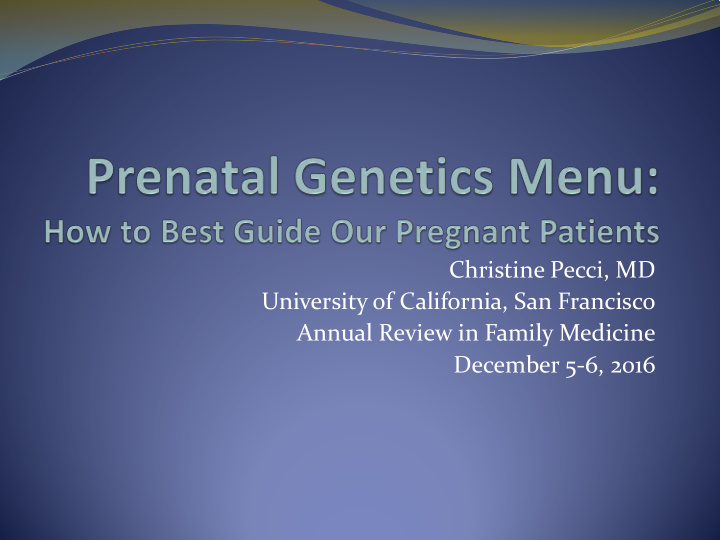



Christine Pecci, MD University of California, San Francisco Annual Review in Family Medicine December 5-6, 2016
A family physician’s approach
The Menu
Genetic disorders and loss Two-thirds of unrecognized SAb Half of recognized 1 st trimester losses 5% stillbirths ACOG Practice Bulletin Number 162, May 2016
Chromosomal Abnormalities 0.4 % of births 18% Trisomy 21 Trisomy 18 12% Trisomy 13 50% Sex Chromosomes 5% Other 15% Obstetrics and Gynecology, Clinical Expert Series ; Dashe July 2016
Apples, oranges and other things Chromosome numbers extra or missing chromosome extra set of chromosome (triploidy) Chromosome structure deletion, duplication, translocation Single gene mutations Neural tube defects Major fetal anomalies (some associated with aneuploidy)
What kind of testing does your patient want, if any? Screening? Diagnosis ?
Listen to your patient “ Counseling for aneuploidy screening has become a conversation ” Dashe, Jodi MD Aneuploidy Screening in Pregnancy Obstetrics and Gynecology July 2016
Risk based on age 1979 Amniocentesis should be offered to >35
Dashe, Jodi MD Obstet Gyn 2016
Evolution of Screening 2007 ACOG statement Screening and diagnostic tests should be offered to all women 1977 1987 1996 2003 1992 • MSAFP • Triple • NT • Quad • First Screen Screen trimester Screening 2011 Introduction of cf DNA
What kind of testing does your patient want, if any? Diagnostic Screening None CVS Amnio
Diagnostic Procedures Procedure Chorionic Villus Amniocentesis Sampling Gestational Age 10-13 weeks 15-20 weeks or later Turnaround time 5-7 day turnaround 7-10 day turnaround Procedure loss rate 0.22% 0.1%
Listen to your patient “ Counseling for aneuploidy screening has become a conversation ” Dashe, Jodi MD Aneuploidy Screening in Pregnancy Obstetrics and Gynecology July 2016
What kind of testing does your patient want, if any? Diagnostic Screening None
What kind of testing does your patient want, if any? Diagnostic Screening None The Menu!
The Menu 1 st trimester Ultrasound 2 nd trimester Cell-free DNA Combined
Options for screening First Trimester Second Trimester hcg + PAPP-A hcg + AFP + estradiol + inhibin 11-14 wks 15-22 wks Can be combined w NT Anatomy scan AFP in 2nd trimester for NTD Includes AFP • 1 st trimester screening gives the patient early results • 2nd trimester screening good for late entry to care • DON’T do both independently • CAN do combined (7 serum markers + NT)
Combined 1st and 2nd trimester screening Sequential testing Stepwise high risk offered diagnostic testing after 1 st trimester Others get results after second trimester Contingent highest risk offered diagnostic testing after 1 st tri lowest risk reassured- no further testing Others get results after 2 nd trimester Integrated testing
Cell-free DNA Circulating DNA fragments placental in origin from apoptotic troploblasts Can be done anytime after 9-10 wks gestation Available in 7-10 days Best for trisomy 21 and 18 but also screens for trisomy 13 and sex chromosome aneuploidies Gender Can be used as primary or secondary screening AJOG June 2016 SMFM Consult Series
Dashe, Jodi MD Obstet Gyn 2016
Limitations of cfDNA 4-8% indeterminate occurs 10% in women >250 lbs Not for multiple gestation Does not detect some genetics abnormalities picked up by traditional testing Placenta and fetus do not always have the same chromosomal complement Placental mosaicism can occur
Discussing results A “positive” or a “negative” screen needs to be interpreted with your patient Reflects the lab’s chosen threshold Positive predictive value likelihood that a patient with a positive screening result has an affected fetus. Negative predictive value likelihood of a patient with a negative screening test who does not have the disease Look at the exact risk and interpret this individually according to your patient’s threshold (values)
Disease Disease Present Absent True False Screen positive positive Positive False True Screen negative Negative Negative PPV = TP/TP+FP NNV=FN/FN+TN
How does US fit into screening?
Ultrasound Gestational Age Number of fetuses Major and minor findings 90% of babies born with congenital anomalies are born to women with no risk factors
Major Structural Anomalies CV, neuro, GI, GU 25-30% of 2 nd trimester fetuses with T21 have a major anomaly that can be detected Trisomy 13 and 18- majority have major If major anomaly seen, offer diagnostic test
Minor “Soft” US markers Nuchal thicknesss Absent or hypoplastic nasal bone Echogenic intracardiac focus Echogenic bowel Pyelectasis Shorted femur or humerus Soft markers present in at least 10% of normal fetuses and can be transient
Screening desired Early entry Late entry 11-14 weeks 15-22 weeks Serum screening +/- NT Ultrasound cfDNA Quad screen (+/- combined)
What is her risk + what are her values? Is diagnostic testing indicated? Offer serum and US screening Low risk (traditional); High risk (cfDNA) Discuss results and decide on whether to pursue diagnostic testing Don’t make management decisions without diagnostic test
Resources Aneuploidy Screening in Pregnancy Jodi S. Dashe. MD OB GYN volume 128 (1); July 2016 181-194 Seminars in Perinatology 2016 Screening for fetal aneuploidy Ultrasound screening ACOG Practice Bulletins May 2016 Prenatal Diagnostic Testing for Genetic Disorders Screening for fetal aneuploidy https://www.perinatalquality.org/Vendors/NSGC/NIPT/
Recommend
More recommend